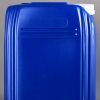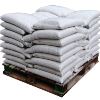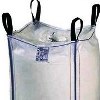| We are manufacturers of Calcium Stearate FCC Food BP Ph Eur USP Grade, Pharmaceutical Excipients in India. We offer Halal and Kosher Calcium Stearate FCC Food BP Ph Eur USP Grade made in an ISO9001, ISO22000 (FSSC22000) cGMP and GLP certified facility. |




Calcium Stearate FCC Food BP Ph Eur USP Grade Manufacturers
CAS Number 1592-23-0
Calcium Stearate FCC Food BP Ph Eur USP Grade SDS GHS, MSDS Sheet of Manufacturers
Calcium Stearate FCC Food Grade Specifications
CAS Number 1592-23-0
DESCRIPTION
Calcium Stearate occurs as a fine, white to yellow-white, bulky powder. It is a compound of calcium with a mixture of solid organic acids obtained from edible sources and consists chiefly of variable proportions of calcium stearate and calcium palmitate. It is unctuous and free from grittiness. It is insoluble in water, in alcohol, and in ether.
Function: Ant caking agent; binder; emulsifier.
REQUIREMENTS
Identification
A. Heat 1 g of Calcium Stearate with a mixture of 25 mL of water and 5 mL of hydrochloric acid. Fatty acids are liberated, floating as an oily layer on the surface of the liquid. The water layer gives positive tests for Calcium.
B. Mix 25 g of Calcium Stearate with 200 mL of hot water, then add 60 mL of 2 N sulfuric acid, and heat the mixture, while stirring frequently, until the fatty acids separate cleanly as a transparent layer. Wash the fatty acids with boiling water until free from sulfate, collect them in a small beaker, and warm them on a steam bath until the water has separated and the fatty acids are clear. Allow the acids to cool, pour off the water layer, then melt the acids, filter into a dry beaker, and dry at 105C for 20 min. The solidification point of the fatty acids so obtained is not below 54
Assay: Not less than 9.0% and not more than 10.5% of CaO, calculated on the dried basis.
Free Fatty Acids (as stearic acid): Not more than 3.0%.
Lead: Not more than 2 mg/kg.
Loss on Drying: Not more than 4.0%.
Calcium Stearate USP NF Specifications
Octadecanoic acid, calcium salt.
Calcium stearate CAS Number 1592-23-0
Calcium Stearate is a compound of calcium with a mixture of solid organic acids obtained from fats and consists chiefly of variable proportions of calcium stearate and calcium palmitate. It contains the equivalent of not less than 9.0 percent and not more than 10.5 percent of calcium oxide (CaO).
Identification:
A: Heat 1 g Calcium Stearate with a mixture of 25 mL of water and 5 mL of hydrochloric acid: fatty acids are liberated and appear as an oily layer floating on the surface of the liquid. The water layer responds to the tests for Calcium.
B: Mix 25 g Calcium Stearate with 200 mL of hot water, add 60 mL of 2 N sulfuric acid, and heat the mixture, with frequent stirring, until the separated fatty acid layer is clear. Wash the fatty acids with boiling water until free from sulfate, collect them in a small beaker, and warm on a steam bath until the water has separated and the fatty acids are clear. Allow the acids to cool, pour off the water layer, melt the acids, filter into a dry beaker, and dry at 105 for 20 minutes: the fatty acids so obtained congeal at a temperature not below 54.
Loss on drying: Dry it at 105 to constant weight, using 2-hour increments of heating: it loses not more than 4.0% of its weight.
Heavy metals: The limit is 10 µg per g.
Calcium Stearate BP Ph Eur Specifications
Action and use: Excipient.
DEFINITION
Mixture of calcium salts of different fatty acids consisting mainly of stearic octadecanoic acid [(C17H35COO)2Ca; M r 607] and palmitic (hexadecanoic) acid [(C15H31COO)2Ca; M r 550.9] with minor proportions of other fatty acids.
Content:
calcium: 6.4 per cent to 7.4 per cent (dried substance),
stearic acid in the fatty acid fraction: minimum 40.0 per cent,
sum of stearic acid and palmitic acid in the fatty acid fraction: minimum 90.0 per cent.
CHARACTERS
Appearance: Fine, white or almost white, crystalline powder.
Solubility: Practically insoluble in water and in ethanol (96 per cent).
IDENTIFICATION
First identification C, D.
Second identification A, B, D.
A. Freezing point: Minimum 53C, for the residue obtained in the preparation of solution S (see Tests).
B. Acid value: 95 to 210.
C. Examine the chromatograms obtained in the test for fatty acid composition.
Results The retention times of the principal peaks in the chromatogram obtained with the test solution are approximately the same as those of the principal peaks in the chromatogram obtained with the reference solution.
D. Neutralize 5 ml of solution S to red litmus paper R using strong sodium hydroxide solution: The solution gives reaction of calcium.
TESTS
Solution S: To 5.0 g of Calcium Stearate add 50 ml of peroxide-free ether, 20 ml of dilute nitric acid and 20 ml of distilled water. Boil under a reflux condenser until dissolution is complete. Allow to cool. In a separating funnel, separate the aqueous layer and shake the ether layer with 2 quantities, each of 5 ml, of distilled water. Combine the aqueous layers, wash with 15 ml of peroxide-free ether and dilute the aqueous layer to 50 ml with distilled water (solution S). Evaporate the ether layer to dryness and dry the residue at 100-105°C. Keep the residue for identification tests A and B.
Acidity or alkalinity: To 1.0 g Calcium Stearate add 20 ml of carbon dioxide-free water and boil for 1 min with continuous shaking. Cool and filter. To 10 ml of the filtrate add 0.05 ml of bromothymol blue solution.
Not more than 0.5 ml of 0.01 M hydrochloric acid or 0.01 M sodium hydroxide is required to change the colour of the indicator.
Chlorides: Maximum 0.1 per cent.
Sulphates: Maximum 0.3 per cent.
Cadmium: Maximum 3.0 ppm.
Atomic absorption spectrometry: To pass the test
Lead: Maximum 10.0 ppm.
Nickel: Maximum 5.0 ppm.
Loss on drying: Maximum 6.0 per cent, determined on 1.000 g by drying in an oven at 105 °C.
Microbial contamination: Total viable aerobic count (2.6.12) not more than 103 micro-organisms per gram determined by plate count. It complies with the test for Escherichia coli.
Calcium Stearate FCC Food BP Ph Eur USP Grade Manufacturers
Anmol Chemicals
S-8, SARIFA MANSION, 2ND FLANK ROAD, CHINCHBUNDER, MUMBAI 400009, INDIA
TEL: (OFFICE) 91-22-23770100, 23726950, 23774610, 23723564. FAX: 91-22-23728264
e-mail: anmolc@mtnl.net.in

Fracture Diverting Agent, Ferric Chloride Hexahydrate, Malic Acid, Skatole & Indole, Potassium Bicarbonate & Carbonate, Sodium Caprylate, Steartic Acid, Tartartric Acid
Exports to USA, Canada, UAE, Dubai, South Africa, Tanzania, Kenya, Nigeria, Egypt, Uganda, Turkey, Mexico, Brazil, Chile, Argentina, Europe Netherlands, Italy, Spain, Germany, Portugal, France, Malaysia, Indonesia, Thailand, Vietnam, Korea, Japan, etc.
Copyright and Usual Disclaimer is Applicable.